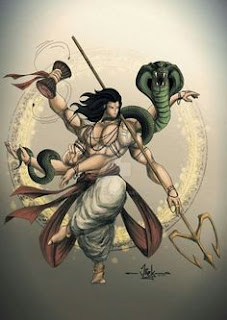Tara Yantra & Benefits Of Wearing The YantraDear all , now let me write about how tara yantra can be made.
The yantra should be drawn in the following order on a bhorja patra with mentioned inscriptions. The 'shaalkone' should be drawn with the moola written on the center followed by saadhyanama and yantranyayas, then the ashtadala is drawn with a encircling veedhi vrutta and bhupura. The yantra should be written from the water made of arikku tree.
On the centre comes the pranava, on the shalkones, from the saptakshari, six are chosen which are hum, hrim, kleem, sau, hum, phal and they are written. On the ashta dala kesara, written the two swaras, the dala have the varga of letters attributed to " Ka" and eight ones which are:
1) kam, kham, gum, gham, gnum
2) cham, chham, jam, tham, njam
3) dam, ddam, daum, ddaum, knam
4) tam, dham, dum, dhamm, num
5) pam, pham, bum, bham, mum
6) yam, ram, lam, vam
7) sham, sshum, sam, hum
8) l(stress)um, ksham
on the veedhi vrutta, the maatruka aksharas will be inscribed, the bhupakones, the beeja kleem is written.
If written in gold, then the water of arakku tree is used to smear it after writing.
A pranaprakista has to be done on this with homas, pujas and sambaadasparsha. After this, the yantra is worn on a yellow silk thread around the neck.
Now the bhala (blessings) and the variants that can come in yantra - Benefits on wearing the yantra
Dear all, various benefits on wearing the tara ma yantra are mentioned below.
If this yantra is tied to the neck of a kid , he will be freed of all diseases and also disturbances from ethereal beings
if this yantra is tied to the left hand of women; those women who have no chance of having kids, they can overcome this conditions and have kids. Also if this done by women who has various types of warts , skin diseases etc , it will be cured.
If this yantra is worn by men, the rags become the riches, even an ugly looking person can transform to a handsome, the kings will win battles and also can have their own kingdoms in no time. For normal humans, it will bestow upon them with fulfillment that of all kamana's or desires.
It is been also mentioned that, tara ma is the most poweful in kaliyuga for fast acquisition of siddhi or perfections and hence the vidhanas have been kept secret. :)) ( The same reason I have removed the vital portions from the details of worship).
This is the perspective of the tantric practitioner. :))
But as an aghori, the interest is not on any of the above mentioned benefits. Now the reader should also know this that, some of the rishi's of gautama lineage have attained complete salvation or moksha with the proper sadhana of this yantra. The variants of this mantra are used by lord brahma and lord vishnu.
These are the major points for an aghori to look upon. According to his mindset, this devata can bestow him everything beyond any doubts. Hence aghori's call tara ma, or smashan tara, the name "Adya"
Adya means 'that which is there from the beginning, the one which has no end and therefore eternal'. let me talk about Adya ma in detail in next post ..











